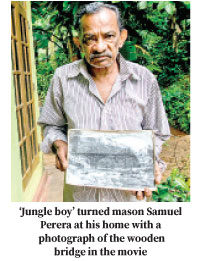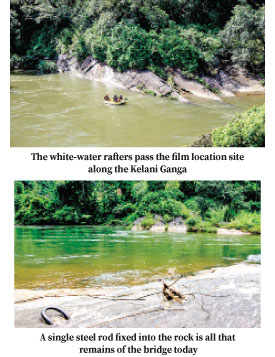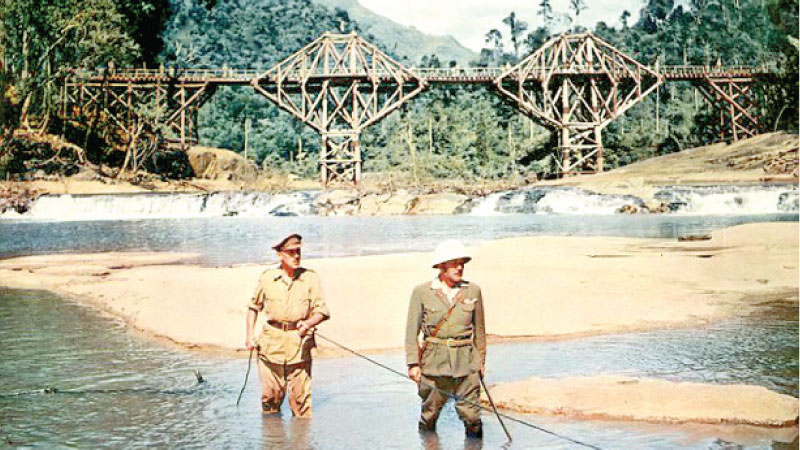 Kitulgala has become synonymous with white water rafting in recent times, but there are many more reasons why this spot, just 88 kilometres from Colombo is well-worth a visit. Director David Lean’s Oscar award-winning epic war film ‘The Bridge on the River Kwai’ was filmed in 1957 on the Kelani Ganga which flows through Kitulgala and the remnants of that bridge can still be found here.
Kitulgala has become synonymous with white water rafting in recent times, but there are many more reasons why this spot, just 88 kilometres from Colombo is well-worth a visit. Director David Lean’s Oscar award-winning epic war film ‘The Bridge on the River Kwai’ was filmed in 1957 on the Kelani Ganga which flows through Kitulgala and the remnants of that bridge can still be found here.
Recently, we had an opportunity to meet villagers and photograph the film location at Kalukohuthenna which is in close proximity to the Kelani Ganga near Kitulgala where the adventurous white-water rafting sport is flourishing.
 “One day the war will be over,” Col. Nicholson had famously said, “And I hope that the people who use this bridge in the years to come will remember how it was built and who built it.” Yes, we all do remember that; at least those who visit Kitulgala and those who go on white water rafting.
“One day the war will be over,” Col. Nicholson had famously said, “And I hope that the people who use this bridge in the years to come will remember how it was built and who built it.” Yes, we all do remember that; at least those who visit Kitulgala and those who go on white water rafting.
Nostalgia
‘The Bridge on the River Kwai,’ the seven Academy Awards winner and World War II British movie, was not shot in Burma but in Sri Lanka. And it was not filmed on the River Kwai but on the Kelani River, exactly 67- years ago. Although, nothing of the bridge remains except the cement base and a few steel rods fixed into the rock, the spot however has a resilient, nostalgic feeling that has grown over the years.
Ceylon, as Sri Lanka was then known was not where producer Samuel Spiegel or director David Lean initially wanted to shoot their World War II epic. Never having visited the island, neither knew of its photographic qualities or its practical advantage as a film location.
As actor Jack Hawkins relates in his autobiography, production meetings in London wrestled instead with the daunting logistics of moving supplies, props, cast and crew into the jungles of Burma. Hawkins, who played Major Warden, an ex-university don who ran a commando training camp, took this as his cue to press Sri Lanka’s case as a cinematic stand-in.
Favourite haunts
Hawkins had spent a great deal of time in Ceylon during the war, which both he and his wife loved. He remembered one of their favourite haunts, a scenic Rest House set on a forested riverfront about 80 kilometres upcountry from Colombo and told Spiegel that it would be the ideal location for the film. When location scouts reported favourably, Spiegel decided to make the film in Ceylon.
And so Kitulgala, an obscure but picturesque village on the banks of the moody and turbulent Kelani Ganga, became the site of the infamous bridge. The Royal Botanical Gardens in Peradeniya – where Lord Mountbatten hid and made it his wartime operational headquarters – and the colonial-era Mount Lavinia Hotel were the other locations for the movie.
Spacious villa
At Kitulgala, a spacious villa was luxuriously fitted out and redecorated for film stars and other VIPs. A few stayed at the three-bedroom Kitulgala Rest House, the inn which Hawkins loved. The Kitulgala Rest House enjoyed serving the film crew with its spicy curry and sago pudding made with the delicious brown palm candy known as kitul jaggery – for which Kitulgala is famous even today.
 For about four months, dozens of local carpenters, builders and railway linesmen were busy on the great wooden bridge and rail tracks at Kalukohutenna, where the river flows past rocky boulders. They worked under the guidance of some foreigners led by art director Don Ashton. When it was completed, everybody was pleased, as the bridge was true to every detail in the drawings and the plans.
For about four months, dozens of local carpenters, builders and railway linesmen were busy on the great wooden bridge and rail tracks at Kalukohutenna, where the river flows past rocky boulders. They worked under the guidance of some foreigners led by art director Don Ashton. When it was completed, everybody was pleased, as the bridge was true to every detail in the drawings and the plans.
However, while the carpenters were working on it, they had not been told that in the end the bridge would be blown up until the work was completed. They were obviously upset that their handsome creation built at great expense would in the end go up in smoke.
A few villagers including the boys and girls had been given minor roles to play in the film. For Samuel Perera, 76, then a nine year-old, he played the role of a ‘jungle boy’ in the film in 1957. We met him at his home in Kalukohuthenna in Kitulgala and he showed us some of the photographs of his role in the movie and also the wooden bridge. Today, he is employed as a mason but has recently suffered a stroke. His wife guides visitors to the bridge location at Kalukohutenna and earns an extra penny.
Samuel Perera remembered that everyone in the village associated with the production received two dress-circle tickets and free travel for the Colombo premiere at the Regal Cinema. In the general excitement and eagerness to spot themselves in the film, many missed parts of the story but almost everybody saw it again when it had a record-breaking run in Yatiyantota, the large town down the river from Kitulgala.
Over the years, the jungle has crept back over the location, covering up the sight, even of the great blast that destroyed the bridge. Where it once stood, the river flows quickly through rocky crags, opening out below to the wide valley used for the film’s unforgettable opening – in which doomed British POWs tramp to an incongruously lilting and upbeat ‘Colonel Bogey March’.
Colombo to Kitulgala, a small wooded town, takes around two-and-a-half hours to reach. Though the town largely attracts rafters, photographers, birders and naturalists, it also offers a serene stay by the gushing river for the not-so-adventurous. In the short drive from Colombo, you see the topography and the vegetation change from coastal to an evergreen, hilly wet zone.
Many people just bathe, swim and play in the shallow parts of the Kelani Ganga which is wide at Kitulgala. It rushes and foams over the rocks at places and in the deeper areas flow more or less silently. White water rafting starts in the morning and goes on till dusk. Towards the end of the rafting, before the last killer rapid, the raft passes the remnants of the bridge built for the movie at Kalukohuthenna.









